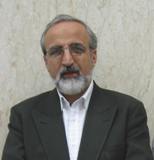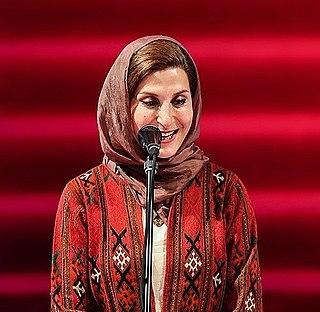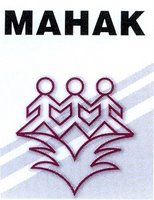
Shahrak-e Gharb or Gharb Town, also known as Qods Town, is a planned town built as a massive project of modern, luxury apartment buildings and villas in the north-western part of Tehran, Iran.

Sardasht is a city in the Central District of Sardasht County, West Azerbaijan province, Iran, and serves as capital of both the county and the district.

Tehran University of Medical Sciences (TUMS) is the largest and most highly ranked medical university of Iran. In September 2008, Iran's Minister of Health, Treatment, and Medical Education, Dr. Lankarani, called TUMS a pioneer in research throughout the country with a noticeable lead over its peer universities.

Rahavard Farahani, known professionally as Golshifteh Farahani, is an Iranian and French actress. She is known for her performances in M for Mother (2006), Body of Lies (2008), About Elly (2009), The Patience Stone (2012), Paterson (2016), Girls of the Sun (2018), Extraction (2020) and its sequel Extraction 2 (2023), and Invasion (2021–present). She was nominated for the Most Promising Actress Award for The Patience Stone at the 2014 César Awards.

Reza Malekzadeh is an Iranian medical scientist and gastroenterologist.

For health issues in Iran see Health in Iran.

Fatemeh Motamed-Arya is a multi-award-winning Iranian actress. She first got involved in theater during her teen years, and received her degree in theater from Tehran Art Institute. She is one of the most significant actresses of post-revolutionary Iranian cinema and has been called "one of the most important actresses and filmmakers of Iran." She has been nominated ten times for the best actress award at the Fajr International Film Festival and won the Crystal Simorgh four times.

Kamranieh is an affluent and luxury neighbourhood located in one of the northernmost parts of Greater Tehran in the area called Shemiran, on the slopes of Alborz mountain range. Kamranieh is known for its luxurious high-rise buildings, costly apartments and massive mansions. Centered on Kamranieh street, the neighborhood lies within Shemiranat County and district one of Tehran municipality.
An earthquake struck the Kerman province of southeastern Iran at 01:56 UTC on December 26, 2003. The shock had a moment magnitude of 6.6 and a maximum Mercalli intensity of IX (Violent). The earthquake was particularly destructive in Bam, with the death toll amounting to at least 34,000 people and injuring up to 200,000. The effects of the earthquake were exacerbated by the use of mud brick as the standard construction medium; many of the area's structures did not comply with earthquake regulations set in 1989.

Rakhshān Banietemad is an internationally and critically acclaimed Iranian film director and screenwriter who is widely considered a premier female director and her films have been praised at international festivals as well as being popular with Iranian critics and audiences. Her title as "First Lady of Iranian Cinema" is not only a reference to her prominence as a filmmaker, but also connotes her social role of merging politics and family in her work. Her signature style is that she focuses on a character representing a part of society to explore it while staying objectively neutral. The first period of Banietemad's cinematic activity originates from dark humor. Still, in the second period of her work, dark humor gives way to serious and influential films, and deeper and broader issues are addressed. Banietemad has a more realistic view of life.

Mahak Hospital and Rehabilitation Complex is a Pediatric Cancer Research and Hospital Center built and organized by Mahak charity. The 120 bedroom complex focuses on the treatment and rehabilitation of children and providing support to their families during treatment.

Marzieh Vahid-Dastjerdi is an Iranian university professor and former parliamentarian, who was Iran's minister of health and medical education. She was part of the President Mahmoud Ahmedinejad's inner circle.
Society of Students Against Poverty, is the first nonpartisan, student NGO in Iran founded in 1999 and had its first official office in Sharif University in 2000. The major activities are tending to social problems, with focus on issues related to children. Since 2010 the NGO is a member of United Nations Economic and Social Council.

Taha Behbahani is a famous Iranian painter, sculptor, set designer, TV and theatre director and a university professor was born in 1947 in Tehran, Iran.
Hamidreza Pouretemad is an Iranian neuropsychologist who is the founder and the Dean of the Institute for Cognitive and Brain Sciences at Shahid Beheshti University and Associate member of the Academy of Science of the Islamic Republic of Iran.
Sanaz Minaie, Performing of the first cooking program in Islamic Republic of Iran Broadcasting by the title of "Sobhgahi Program" which was welcomed by all the audience; and then was resulted in repetition of that in afternoon in "Tasvir e Zendegi" program and producing 7 DVDs about the history and civilization of Iran in terms of food. Performing and broadcasting cooking programs in "Aftab Channel" and for in international programs Production, performance and propagation of educational DVDs confirmed by Ministry of Culture and Islamic Guidance; all the income earned was allocated to "Mahak, Society to support children suffering from cancer" (2009) Expert in TV program naming "Dastpokht Khodemani in 2016. Minaie gave a talk at TEDxTehran about the history of Persian cousin.
Dr. Mina Izadyar was a prominent Iranian professor and pediatrician in the field of hematology and oncology. Her efforts and research alongside her colleagues resulted in the reduction of live-born infants with acute Thalassemia from 2500 to just 300 per year. She was also co-founder and director of Iranian Thalassemia Society
Parvaneh Vossough was an Iranian physician, chiefly known for her work for children with cancer.
Anarchism in Iran has its roots in a number of dissident religious philosophies, as well as in the development of anti-authoritarian poetry throughout the rule of various imperial dynasties over the country. In the modern era, anarchism came to Iran during the late 19th century and rose to prominence in the wake of the Constitutional Revolution, with anarchists becoming leading members of the Jungle Movement that established the Persian Socialist Soviet Republic in Gilan.













